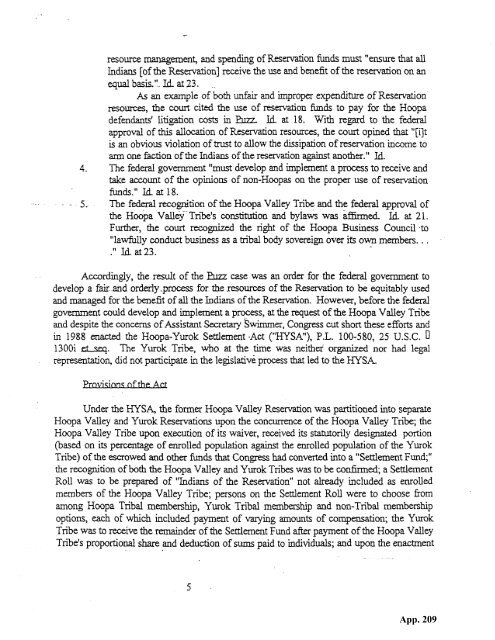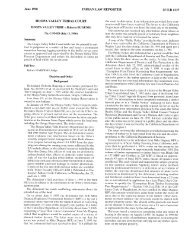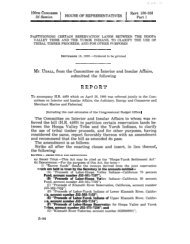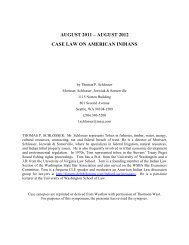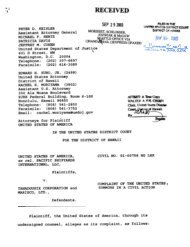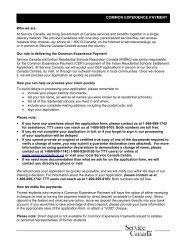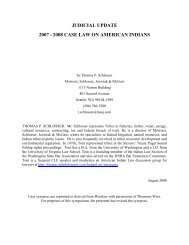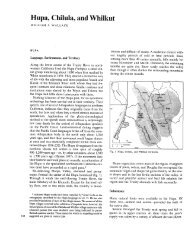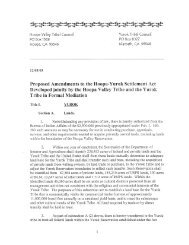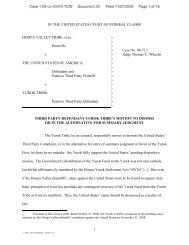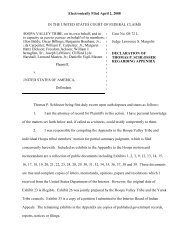Hoopa appendix supporting summary judgment - Schlosser Law Files
Hoopa appendix supporting summary judgment - Schlosser Law Files
Hoopa appendix supporting summary judgment - Schlosser Law Files
Create successful ePaper yourself
Turn your PDF publications into a flip-book with our unique Google optimized e-Paper software.
esource management, and spending ofReservation funds must “ensure that all<br />
Indians [of the Reservation] receive the use and benefit of the reservation on an<br />
equal basis.~Id.. at23.<br />
As an example of both unfair and improper expenditure of Reservation<br />
resources, the court cited the use of reservation funds to pay for the <strong>Hoopa</strong><br />
defendants’ litigation costs in Pn~ Id. at 18. With regard to the federal<br />
approval of this allocation ofReservation resources, the court opined that “[i]t<br />
is an obvious violation of trust to allow the dissipation of reservation income to<br />
arm one faction of the Indians of the reservation against another.” Id.<br />
4. The federal government “must develop and implement a process to receive and<br />
take account of the opinions of non-<strong>Hoopa</strong>s on the proper use of reservation<br />
funds.” Id. at 18.<br />
- 5. The federal recognition of the <strong>Hoopa</strong> Valley Tribe and the federal approval of<br />
the <strong>Hoopa</strong> Valley Tribe’s constitution and bylaws was affirmed. Id. at 21.<br />
Further, the court recognized the right of the <strong>Hoopa</strong> Business Council ~to<br />
“lawfully conduct business as a tribal body sovereign over its own members...<br />
.“ IrLat23.<br />
Accordingly, the result of the Pu77 case was an order for the federal government to<br />
develop a fair and orderlyprocess for. the resources of the Reservation to be equitably used<br />
and managed for the benefit of all the Indians ofthe Reservation. However, before the federal<br />
government could develop and implement a process, at the request ofthe <strong>Hoopa</strong> Valley Tribe<br />
and despite the concerns ofAssistant Secretary swimmer, Congress cut short these efforts and<br />
in 1988 enacted the <strong>Hoopa</strong>-Yurok Settlement -Act (“HYSA”), P.L. 100-580, 25 U.S.C. U<br />
1300i et ~ The Yurok Tribe, who at the time was neither organized nor had legal<br />
representation, did not participate in the legislativ~process that led to the HYSA.<br />
Provisions ofthe Ac~t<br />
Under the HYSA, the former <strong>Hoopa</strong> Valley Reservation was partitioned into separate<br />
<strong>Hoopa</strong> Valley and Yurok Reservations upon the concurrence of the <strong>Hoopa</strong> Valley Tribe; the<br />
<strong>Hoopa</strong> Valley Tribe upon execution of its waiver, received its statutorily designated portion<br />
(based on its percentage of enrolled population against the enrolled population of the Yurok<br />
Tribe) of the escrowed and other funds that Congress had converted into a “Settlement Fund;”<br />
the recognition ofboth the <strong>Hoopa</strong> Valley and Yurok Tribes was to be confirmed; a Settlement<br />
Roll was to be prepared of “Indians of the Reservation” not already included as enrolled<br />
members of the <strong>Hoopa</strong> Valley Tribe; persons on the Settlement Roll were to choose from<br />
among <strong>Hoopa</strong> Tribal membership, Yurok Tribal membership and non-Tribal membership<br />
options, each of which included payment of varying amounts of compensation; the Yurok<br />
Tribe was to receive the remainder ofthe Settlement Fund after payment of the <strong>Hoopa</strong> Valley<br />
Tribe’s proportional share and deduction of sums paid to individuals; and upon the enactrrient<br />
5


